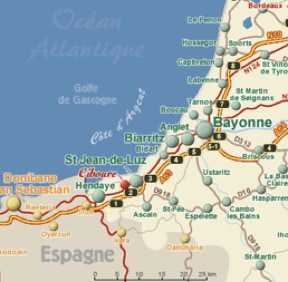
Maurice Ravel
(1875 - 1937)
COMMENTARY
Ravel’s Life and Music



Maurice Ravel was born on March 7, 1875 in the small village of Ciboure, located at the southwestern tip of France, a short distance from the Spanish border. This location in the Basque Pyrenees would be quite important to the composer and his entire output of musical creations. His mother was of Basque origin, and his father was a Swiss civil engineer. These two elements were to have a profound effect on the life and music of the composer: his mother’s Spanish background is evident throughout the works of Ravel, and his father’s attention to fine detail (he was also an inventor), which was inherited by his son, prompted Igor Stravinsky to dub Ravel “The Swiss Watchmaker”.
Among his earliest and most treasured memories were the Spanish folk melodies sung to him by his mother, and through her, he inherited a love of the Basque country, its people, and its folklore, as well as a deep sympathy for the music of Spain. Is it any wonder that many of the major masterpieces of this composer have Spanish roots and themes, such as his opera The Spanish Hour, Bolero (of course), Rapsodie espagnole, Habanera, Don Quichotte à Dulcinée, and numerous other works?
It is also important to note that Ravel absolutely venerated and adored his mother, and her death proved to be a blow from which the composer never fully recovered (he was basically unable to compose for almost three years thereafter). Ravel’s attachment to his mother was undoubtedly the deepest emotional tie of his entire life.
Ravel had a happy childhood (he had one brother, Edouard), and when it became clear that Maurice would pursue a career in music, he received unqualified support and encouragement from his family. Ravel took his first piano lessons at age seven, and at age fourteen he was admitted to the world-famous Paris Conservatory of Music, where he studied composition with Gabriel Fauré. He began to attract attention as a composer around 1900, when he produced the instantly popular Pavane for a Dead Princess. Ravel’s highly progressive and individualistic piano writing was also adding to his luster, as can be heard in his famous Jeux d’Eau of 1901.
From the beginning of his career, Ravel’s name was linked with that of Debussy, a fact that often irked Ravel. Although Ravel recognized the influence of the older French master on his music, he also averred that many of the “new” piano techniques attributed to Debussy were actually pioneered by himself at an earlier date. Unlike Debussy, who won the coveted Prix de Rome award at the Conservatory, Ravel tried five times and was never awarded it. This astonishing lack of recognition (by the fifth try he was already an internationally-known composer!) ultimately led to a shake-up of the entire Paris Conservatory and created a major scandal in France.

Ravel’s birthplace was Ciboure, located very close to the France-Spain border.


Ravel’s beloved mother, Marie.
Claude Debussy
Igor Stravinsky
Serge Diaghilev
Ravel first gained international success and recognition with his opera The Spanish Hour, composed in 1907-09 and first performed in 1911. Even more important than this was the arrival of the Ballets Russe in Paris in 1909, headed by its brilliant impresario Serge Diaghilev.
Through Diaghilev, Ravel met Igor Stravinsky, who composed The Firebird, Petrouchka, and The Rite of Spring for Diaghilev and the Ballets Russe. Stravinsky and Ravel soon became close friends and admirers of each other’s music. When Diaghilev commissioned Ravel to compose a ballet, the composer jumped at the opportunity, and the result was his most famous work (excepting Bolero, of course), and his longest and largest work of his career: Daphnis et Chloé.
Unfortunately, Daphnis was not a tremendous success at its premiere in 1912. This was due to many factors, including the sensation created by Stravinsky’s Petrouchka of the previous season, problems with costumes and sets, and problems in the score itself (when Ravel was asked how he managed to complete the troublesome finale of the ballet, he replied,
“It’s quite simple: I put Rimsky-Korsakov’s Scheherezade on the piano and copied it.”
At the outbreak of World War I in 1914, Ravel decided to join the army. However, he was disqualified from active service because of his weight (he was underweight by two kilograms). Wishing to serve his country, he became a driver with the motor transport corps.
With the death of Debussy in 1918, Ravel became the most famous and widely-regarded living French composer. However, as stated above, the death of his beloved mother (in 1917) had such a catastrophic effect on the composer that his output dwindled to, on average, one work per year from that period until his last works (composed in 1933).
The year 1932 marks the beginning of Ravel’s tragic final period. He was involved in a serious taxi accident and was severely injured. The accident had a traumatic effect on the composer and symptoms that marked his tragic decline began shortly thereafter. His illness, the symptoms of which were described as ‘ataxia’ (the inability to co-ordinate voluntary movements) and ‘aphasia’ (the inability to express thoughts in words), left Ravel in the pitiable state of being able to hear music in his head but not being able to write it down or play it on the piano, or even describe it. Soon he was no longer able to sign his name, speak coherently, or even move without difficulty. His death in December 1937 followed an unsuccessful brain operation (this is similar to his friend George Gershwin, who died on the operating table during brain surgery a mere five months before Ravel).

Daphnis et Chloé,
Marc Chagall (1961)

Russisches Ballett,
August Macke (1912)

Ravel in his army outfit…
Ravel at work late in life



George Gershwin
Ravel’s gravesite in Paris
